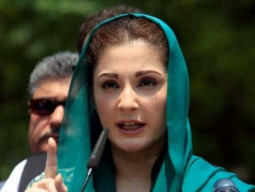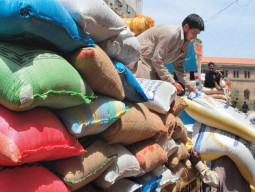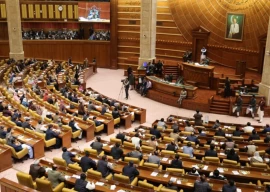
Wisconsin Laboratory of Hygiene and Peterson-Radar-Hawnn Director Dr James J Schauer, made these recommendations while speaking to The Express Tribune on Monday. He underlined that it was really important to put efforts in air quality monitoring to understand sources of atmospheric particulate matter (PM2.5).
“We conducted a year-long study in collaboration with the University of Engineering and Technology (UET), Lahore in 2007-08 and found that mobile sources have a major impact in PM2.5 atmospheric pollution, besides burning of biomass and a smaller amount of dust,” he said.
The study also highlighted that some of the PM2.5 sources also include gas emissions that create new particles as a result of chemical reactions and there is a seasonality in pollution patterns.
Lahore chokes: air quality second worst in the world
The PM2.5 is very fine particles of dust and other harmful elements of less than 2.5 micrometres that have tendency to stay longer in the air due to their small size and lightweight and increase chances of humans and animals inhaling them into their bodies because particles of such small diameter can bypass nose and throat and penetrate deep into the lungs and some may even enter the circulatory system.
Dr Schauer said though there were similarities in major sources of atmospheric air pollution in most developing countries, it is hard to generalise because of seasonality and composition.
“It all depends on industrial and human activities. But I believe in many developing countries vehicles are an important source of air pollution. In certain parts of the world people also burns solid fuels that also cause PM2.5 atmospheric air pollution, especially when the weather is colder,” he pointed out.
Responding to a question about cross-border air pollution in the provincial capital, the US Science Envoy for Air Quality said: “I can’t give you the quantitative answer about relative trans-boundary [air pollution] issue but it is important that we, the scientific community, do study to understand the issue. We have learnt from various studies that solving the wrong problem does not help anybody. Actually, we need more data to quantify the exact sources of pollution. It is not reasonable if we blame only one source as the wind blows both ways,” he maintained.
Responding to another question, he pointed out that two kinds of monitoring were required to understand the problem. One of them is pollution concentration and the other is its chemical composition to interpret the exact sources and causes and not much is being done in data collection and interpretation.
There is really a need to do more in this area as it is happening in the US and other parts of the world.
He also underlined the need of developing a regional strategy, learning from the experience of other cities in developed and developing countries that have been effectively managing air quality and understanding the latest technologies to control the causes of air pollution.
“I don’t think we need huge resources; a few dozen monitoring sites can help in gathering qualitative data. We need more investment in the idea of source attribution and source rapprochement to understanding more about the solution. It is not necessary to have thousands or even hundreds of monitors. We might have a dozen monitoring sites in the US and there might be a few supplementary sites as well,” he indicated.
Answering another question, Dr Schauer said it is very important to have policies to make higher quality fuel and it should be certainly an important strategy for going forward. “I think, it’s not only the fuel but pairing of high-tech vehicles with high-quality fuels together and those have to have happened. You can’t move forward without advanced vehicles and high-quality fuels,” he said.
He pointed out that there were very well-established technologies that could reduce emissions. “In the US, we burn a lot of coal and a lot of petroleum but we require them to have adequate emission control technology. As we think about the long term considering climate change, we certainly want to think about renewable energy and clean technologies. But in the short term we need to focus on appropriate controls,” he maintained.’
Lahore reels under alarming level of air pollution
Responding to a question about increased forest cover, he said trees help create a barrier and reducing pollution exposure but it is really difficult to remove pollution from the air. He also highlighted the need for establishing partnerships between academia, government, industry and civil society.
He said lowering barriers, sharing data and enhanced partnership will help to solve problems.
Dr Schauer has been a professor at the University of Wisconsin-Madison in the College of Engineering since 1998 and holds the position of Peterson-Radar-Hawnn Professor of Civil and Environmental Engineering. As a Science Envoy for Air Quality, Dr Schauer highlights American scientific strategies and technologies for mitigating poor air quality, with a focus on South Asia.
Published in The Express Tribune, January 14th, 2020.


















COMMENTS
Comments are moderated and generally will be posted if they are on-topic and not abusive.
For more information, please see our Comments FAQ